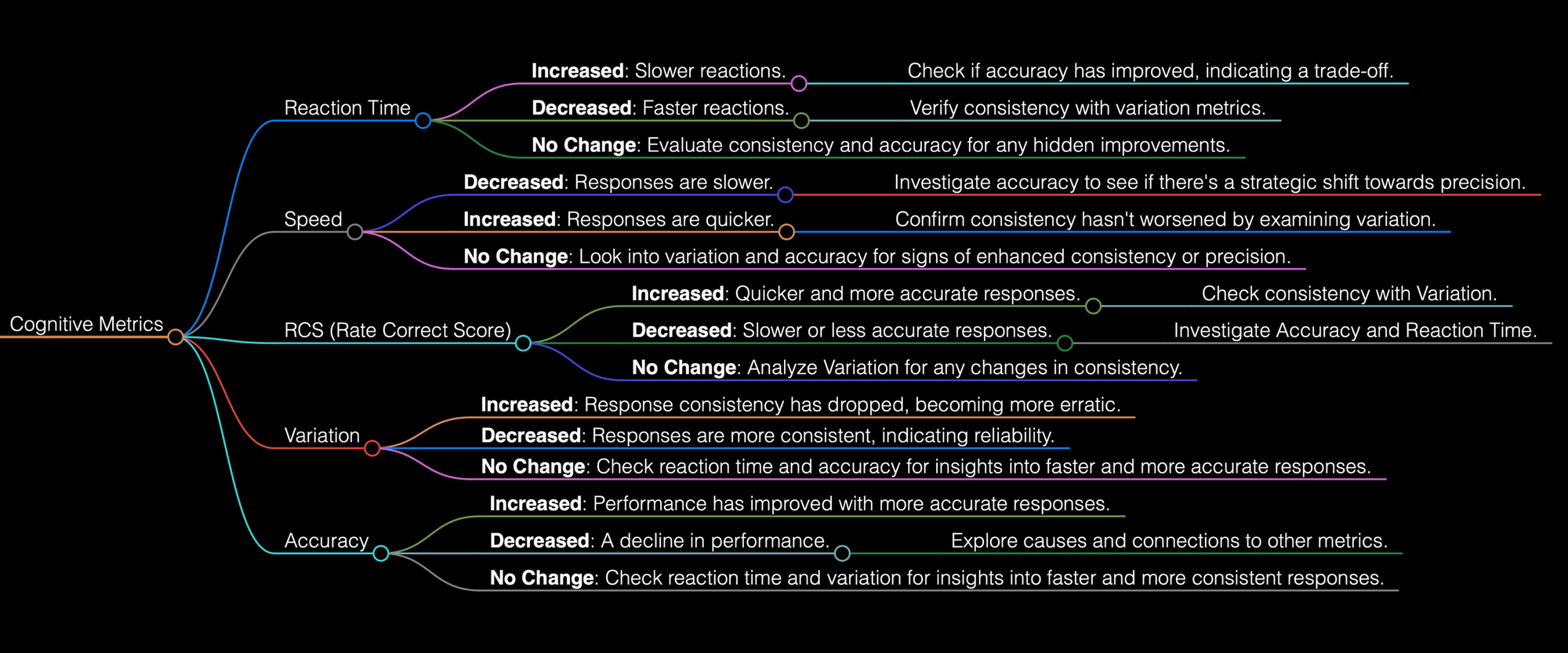Speed: Ensuring Reliability in Cognitive Performance Measurements
Unlike the more commonly cited metric of reaction time, speed offers a comprehensive lens through which to view an athlete's performance.

Unlike the more commonly cited metric of reaction time, speed offers a comprehensive lens through which to view an athlete's performance. This is because speed normalizes reaction time data, ensuring reliability. Outliers—extreme data points like unusually fast or slow responses—can significantly distort the understanding of an athlete's true capabilities. Normalizing this data helps minimize the impact of outliers, providing a clearer, more accurate picture of performance.
So, How Is Speed Calculated?
First, we sum all the reaction times:
500ms, 900ms, 300ms, 500ms, 1200ms, 300ms, 500ms, 345ms, 233ms, 984ms, totaling 5762ms. Next, we divide this total by the number of trials (10), yielding an average reaction time of 576.2ms.
To calculate speed, we calculate 1000 divided by the reaction time for each response, sum these values, and then divide by the number of trials to obtain the average speed.
For instance, 1000 divided by 500ms equals 2.
So, for all our trials, we get:
2, 1.11, 3.33, 2, 0.83, 3.33, 2, 2.89, 4.29, 1.01
The total speed is 22.79.
We then divide this by the number of trials (10) to get our average speed of 2.27.
Thus, our average reaction time is 576.2ms, and the corresponding speed is 2.27.
You may question why we can't just divide 1000 by the average reaction time (576.2ms) to obtain 1.73. This approach, however, would be incorrect because it only computes the average of the entire task, rather than each individual reaction time. Consequently, it wouldn't normalize the data distribution.
This is where the calculation of speed per reaction time becomes critical. It serves to normalize the data distribution, enhancing the relevance and accuracy of the results. This normalization process diminishes the impact of any outliers, leading to a more precise portrayal of an athlete's performance.
Now, let's move on to how to interpret speed data.

Decreased Speed
Observing a decrease in an athlete's speed may initially seem concerning. However, this slower pace could indicate a strategic shift towards improving accuracy, suggesting a deliberate decision to prioritize precision over sheer velocity. This scenario underscores the need for athletes to find a balance, striving for speed that does not sacrifice accuracy.
Increased Speed
An increase in speed typically signals improved information processing and decision-making capabilities. However, this improvement should be viewed with caution. It's vital to ensure that the gain in speed does not compromise the athlete's accuracy or consistency. True performance enhancement is achieved when speed is coupled with reliable and steady execution.
No Change in Speed
Stability in speed, especially when paired with advancements in other performance metrics, is often a sign of significant progress. It may indicate that an athlete has successfully refined their technique, maintaining their quickness while also becoming more precise and consistent. This balance is crucial for athletes aiming to reach the pinnacle of their sport.
Changes in speed—whether a decrease, increase, or consistency—offer deep insights into an athlete's development and strategic approach. The essence of high-level performance lies not merely in the raw metrics but in the intricate balance between speed, accuracy, and consistency. By adopting a comprehensive approach to the analysis of cognitive metrics, incorporating data normalization, and recognizing the multifaceted nature of athletic performance, coaches and athletes can identify genuine areas for improvement and optimization.
🌐 Connect With Us
🌍 Soma Technologies: Engineered to enhance human performance.
📸 Instagram: Dive into our world through exclusive photos and stories.
👥 Facebook: Join our community for the latest updates and discussions.
📈 LinkedIn: Connect with us professionally and stay informed about industry news.
🎥 YouTube: Watch our latest videos, tutorials.
🐦 X: Follow us for instant updates, news, and engaging tweets.
